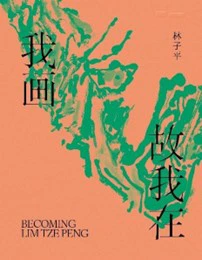National Gallery Singapore presents Becoming Lim Tze Peng, its first solo exhibition on Singapore’s oldest living artist, showcasing cherished works from public art collections
The exhibition presents compelling stories behind the journey and artworks of the centenarian artist and Cultural Medallion recipient, with his lifelong passion for his craft.
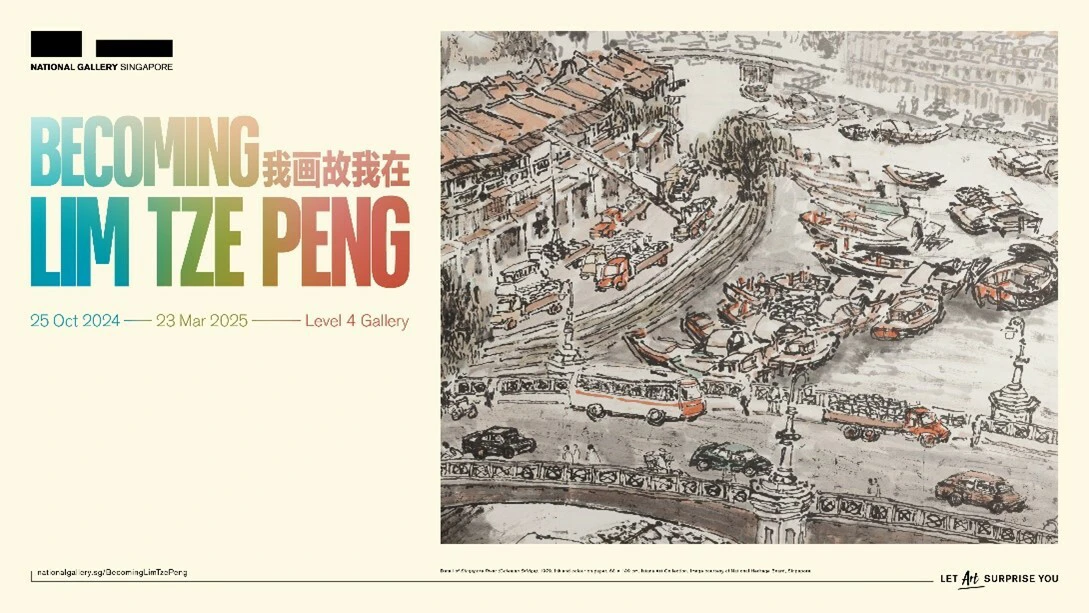
Trace the artistic evolution of 103-year-old Singaporean artist Lim Tze Peng at Becoming Lim Tze Peng, National Gallery Singapore’s first solo exhibition dedicated to the nation’s oldest living and active artist. The bilingual exhibition features over 50 artworks specially selected from Singapore’s public art collection1, including an artwork of the Singapore River from The Istana’s collection, as well as from the artist’s personal collection. Rare archival materials from Lim’s studio and his peers also form a complementing parallel narrative to his art, together with two never before seen video recordings of the artist at work in 2013 filmed for National Gallery Singapore. The centenarian artist’s lifelong journey and dedication to his craft is captured in this captivating exhibition, comprising sketches, calligraphy, and paintings in ink, and oil genres, dating back to his early artist days in 1946 to a recently completed work from 2023.
1The public art collection featured in this exhibition include National Collection works from The Istana, National Gallery Singapore and Singapore Art Museum, and from institution lenders Chung Cheng High School (Main), Nanyang Academy of Fine Arts, and NUS Museum.
From 25 October 2024 to 23 March 2025, visitors can explore a dynamic collection of Lim’s artworks. Marvel at nostalgic depictions of well-loved scenes of everyday Singapore, immerse yourself in magnificent landscapes drawn from his art expeditions across Southeast Asia and beyond, and experience Lim’s bold and expressive ink works, including his distinct style of calligraphy, “hu tu zi” (糊涂字).
Lim Tze Peng occupies a unique position in Singapore’s art history for his persistent innovation in the genres of ink painting and calligraphy, skilfully blending ancient practices with contemporary relevance through dialogues with different traditions and modernities. The exhibition delves into the compelling stories behind the centenarian artist’s complex art evolution, shaped by his friendships, travels, and persistent pursuit of artistic freedom. Becoming Lim Tze Peng is the fourth instalment of the Gallery’s SG Artist series, spotlighting visionary Singaporean artists who reflect the post-independence spirit and innovation.
Dr. Eugene Tan, CEO and Director of National Gallery Singapore says, “Lim Tze Peng is a seminal artist in Singapore’s visual arts canon, especially in ink painting. Becoming Lim Tze Peng celebrates the illustrious career of Singapore’s well-loved centenarian artist, his dedication to his craft, and explores the evolution of his art practice, which he continues to develop to this day. His artworks connect audiences with the essence of the Singaporean identity through the lens of art, and this exhibition deepens the Gallery’s ongoing academic research on local ink art narratives.”
Artist Mr Lim Tze Peng says, “I would like to thank National Gallery Singapore for the opportunity to showcase my work at the state level and their efforts to champion art from Singapore. Creating art has been my lifelong passion, and I have devoted myself to it wholeheartedly. I am very excited to see a variety of my artworks from nearly 80 years displayed in this exhibition. I hope that visitors will connect with these pieces on a deeper level as they appreciate my art.”
Highlighting the non-linear nature of Lim’s artistic evolution, the exhibition presents the development of his practice through three thematic sections: From Dàpō to Xiǎopō, The World Outside, and On My Own Grounds.
From Dàpō to Xiǎopō: Immerse in nostalgic scenes of heritage Singapore through the eyes of Lim Tze Peng and learn of his local impact
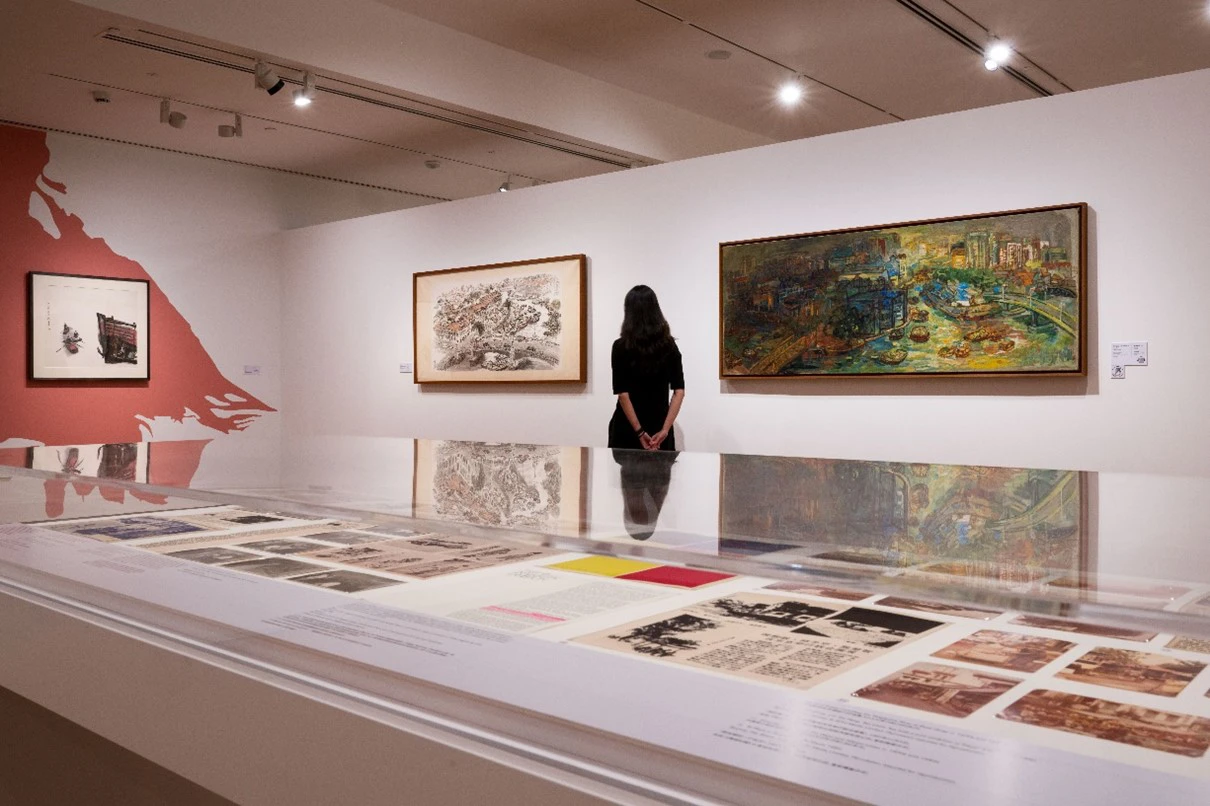
The vibrant, everyday scenes of Singapore were Lim’s favourite subjects. These include familiar local scenes such as the Singapore River, Sultan Mosque, coffee shops, and wet markets. This section offers visitors a glimpse into the landscapes of heritage Singapore from Dàpō to Xiǎopō (‘Big Quay’ to ‘Little Quay’) – colloquial terms popular amongst the older Chinese-speaking communities which refer to the area from present-day Outram Park to Kampong Glam.
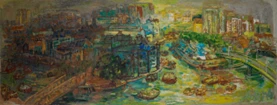
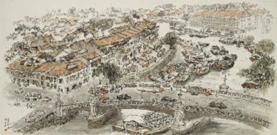
Two paintings of an iconic landmark, the Singapore River, sit side by side in this exhibition: Singapore River II (1976), an oil painting which was the first artwork that Lim donated to Singapore’s National Collection; and Singapore River (Coleman Bridge) (1979), an ink painting from the Istana Art Collection. Painted three years apart, these two works present distinct depictions of the waterway with different mediums. Visitors are invited to draw comparisons between the artworks, introducing them to the evolution of Lim’s artistic practice when he transitioned from oil to ink paintings.
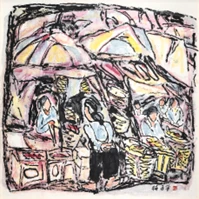
Hawker (2013-2014) depicts a vibrant ink and colour market scene in Singapore from the Chung Cheng High School (Main) Collection. Created just a decade ago, Hawker showcases Lim’s innovative take on blending three art forms – epigraphy, calligraphy, and painting – into a single work. Lim created a new visual language in bringing together textured ink washes and broken brushstrokes to create a harmonious overview that highlights the innovative and vast ways that Lim expresses himself through art.
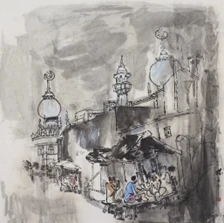
Collection of National Gallery Singapore.
Untitled (Blue Mosque) (c. Late 1970s) presents Lim’s interpretation of Sultan Mosque and its surrounding areas, located in the Kampong Glam district today. While the mosque is no longer blue, the artwork reflects a culmination of his memories of the mosque from the 1950s to 1960s.
Lim Tze Peng frequented the neighbourhoods located in Dàpō and Xiǎopō to conduct outdoor drawing sessions with his peers, and co-organised some of the earliest public exhibitions of these areas. In addition to the paintings, visitors can look forward to news clippings and photographs from the 1970s and 1980s that recorded these intrinsic moments in the artist’s career. Some of these photographs were uncovered from Lim’s library and share similar scenographic perspectives as his featured paintings.
The World Outside: Lim Tze Peng’s creative drive and inspiration from his artistic pursuits abroad
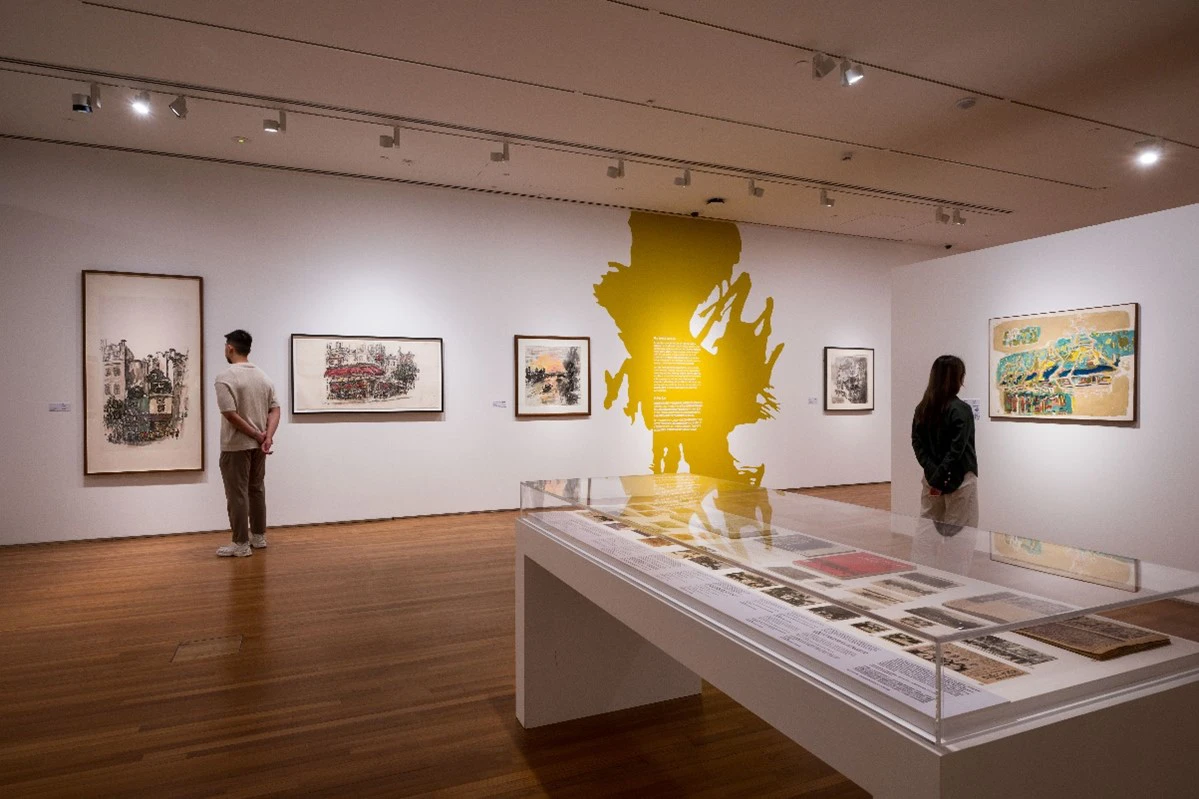
Beyond Singapore’s everyday life and scenes, Lim Tze Peng also drew inspiration from his artistic expeditions with his artist friends from different art groups. The second theme and section of the exhibition focuses on subject matters beyond Dàpō and Xiǎopō, and includes Southeast Asia and Europe.
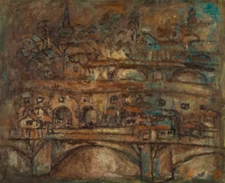
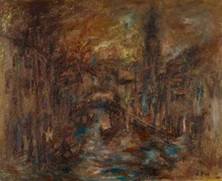
Venice (1996) and Ponte Vecchio, Florence (1996) were oil paintings born from a twenty-day art tour to Europe in 1996, organised by the Society of Chinese Artists for its members. Accompanied by over twenty peers, Lim visited heritage sites and studied the works of European old masters and modernists housed in museums across the continent. This trip marked his first in-person encounter with Europe.
Venice portrays the city in loose, jagged brushwork to mimic a sense of movement and instability. Meanwhile, Ponte Vecchio, Florence, is characterised by bold lines contouring the architectural structures, which gradually lose their intensity to allude depth and distance of the scene – a compositional strategy commonly found in traditional ink paintings that dates back to the Tang and Pre-Tang dynasties. These artworks foreground Lim’s diverse art styles and bring to attention Lim’s ability to incorporate techniques from the ink painting tradition into Western landscapes and mediums.
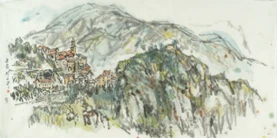
View of the Hills (2000), which depicts the renowned mediaeval village of Saorge in Southern France, was painted during his artist residency in Paris organised by the Nanyang Academy of Fine Arts in 2000. Instead of typical depictions of architecture that Europe is known for, Lim drew attention to the natural landscape where irregular rock formations and lush foliage take centre stage. The portrayal of the architecture through angular shapes and dots is juxtaposed against the textured brushworks of the undulating slopes, which brings to mind the peaks of majestic mountains in the Song dynasty ink paintings.
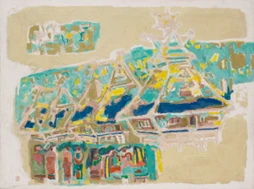
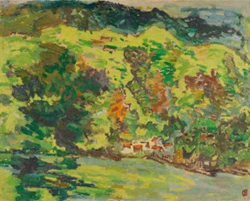
Closer to home are two paintings depicting the landscapes of Indonesia. Sumatra (1970) and Lake Toba (1970) are vibrant oil painting portrayals of Indonesian architecture and pastures, which were the result of art expeditions around the Southeast Asian region with the Ten Men Group during the 1960s and 1970s. Each trip was akin to a cultural immersion programme: artists sketched outdoors, interacted with villagers from different ethnic groups, exchanged ideas with local art communities and absorbed the creative stimuli and visual inspirations found in their tropical surroundings. Lim Tze Peng was one of the core founding members of the group, alongside artist friends Chen Cheng Mei, Choo Keng Kwang, and Yeh Chi Wei.
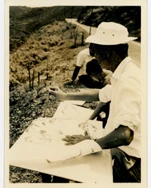
In 1970, the trip to Indonesia served as a pivotal moment in Lim’s artistic journey, as it marked the start of his exploration into Chinese ink painting. Captured on camera, two rare photographs show Lim painting outdoors with a Chinese ink brush while overlooking Lake Toba. Visitors can find out more and study these moments from Lim’s art expeditions dated between the 1960s and 2000s through different archival materials in the vitrine.
On My Own Grounds: Lim Tze Peng’s own rules and distinctive artistic style
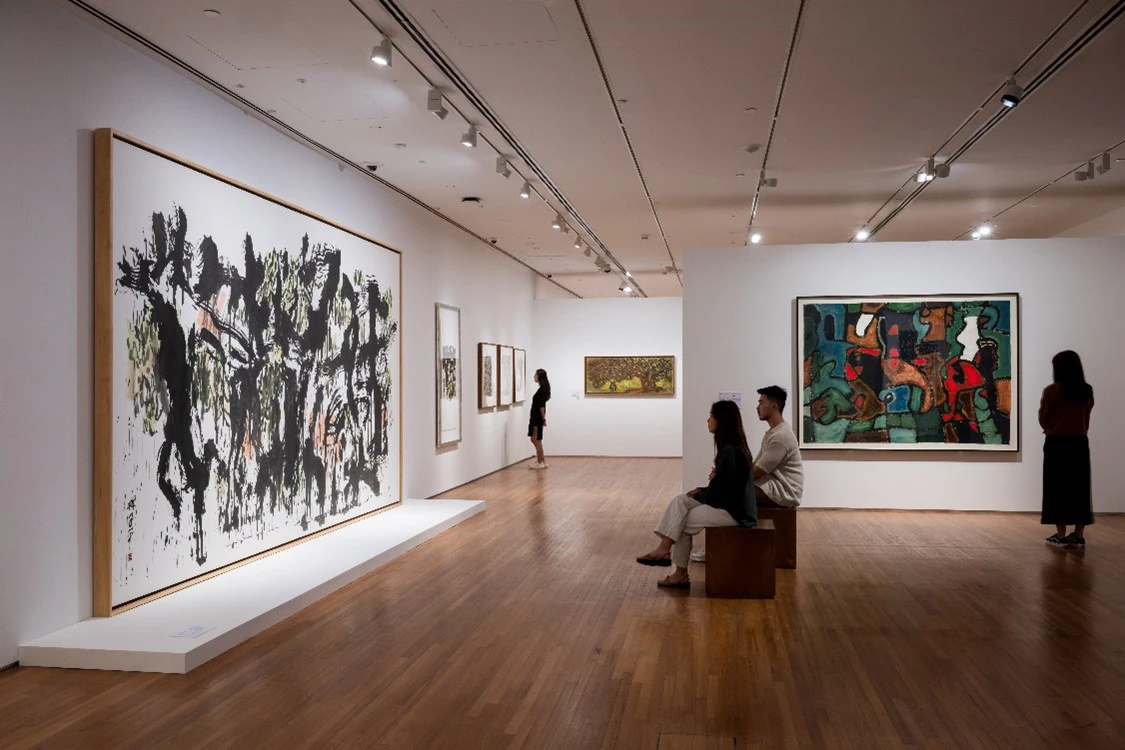
The third theme and section of the exhibition explores Lim’s pursuit of artistic freedom and the creation of his own artistic rules, which are grounded in his aesthetic sensibility and creative methods. Over the course of his illustrious career, Lim has evolved his artistic style from representational paintings to expressive forms that combine the visual qualities of varying mediums of art. This freedom of exploration and expression eventually led to the invention of his own unique creation, “hu tu zi” (糊涂字) – also known as ‘muddled calligraphy’ or ‘muddled characters’.
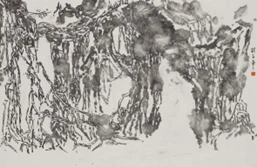
One of his approaches was experimenting with negative space and voids in painting. [Not Titled] (Forest Path) (1985), a horizontal composition comprising a mix of smooth and broken brush strokes as well as varying textures and spacing, showcases Lim’s use of space in his artworks and shows his earliest consciousness of abstraction, which were inspired by banyan trees. Visual tension surfaced within the artwork as there is no identifiable form, subject matter, or colour. The white space between the branches and aerial roots of the banyan tree creates a sense of distance and volume, which in turn guides the rhythm and pacing of the artwork. It also highlighted visual similarities of “hu tu zi” and the visual languages that he was experimenting with.
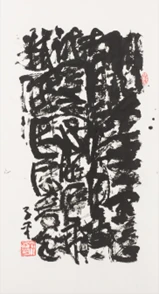
Untitled (Calligraphy No. 7) (2008) presents a stanza from a Tang dynasty poem by Meng Haoran in an expressive manner that blends the fluidity of classical Chinese cursive script with a modern aesthetic twist. Without obvious iconographic subjects, this compact vertical piece is composed of a variety of smooth and angular lines created with both wet and dry brushwork. The lines frequently intersect and crisscross, with weight and distance conveyed by the varying intensities of the ink. Darker tones suggest greater weight and proximity, while lighter tones indicate the reverse. Empty spaces rhythmically engage with the lines, creating a visual tension that guides the work's rhythm, much like the tempo of a musical composition.
Lim outlined six principles in what constitutes “A Good Painting” in one of his sketchbooks. The doctrine places foremost emphasis on the importance of aesthetics, locality, rhythm, and seeing when it came to interpreting life. Visitors can learn more about these six principles in the exhibition vitrine. Looking at Lim’s 21st-century artworks with his principles in mind will allow a deeper understanding of his reasoning and artistic considerations, particularly in interpreting his recurring motifs.
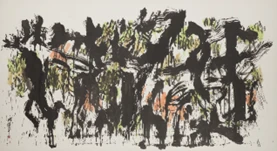
Inroads No. 1 (2006) is Lim’s largest artwork in this exhibition. Measuring almost five-metres-wide, the impressive ink and colour painting features a variety of angular and curvilinear lines with sudden starts and stops, flowing transitions, and rhythmic continuity. This piece was last exhibited at SAM in 2009 and later travelled to National Art Museum of China in Beijing and Liu Haisu Art Museum in Shanghai as part of the artist’s overseas retrospective exhibition.
Becoming Lim Tze Peng at National Gallery Singapore
Becoming Lim Tze Peng runs from 25 October 2024 to 23 March 2025 at National Gallery Singapore’s Level 4 Gallery. A General Admission pass is required, with free entry for Singaporeans and Permanent Residents. For more information, please refer to the attached annexes or visit www.nationalgallery.sg/BecomingLimTzePeng. Media assets are available through this link
- Annex A: Lim Tze Peng’s Biography
- Annex B: Becoming Lim Tze Peng Artwork Highlights
- Annex C: Becoming Lim Tze Peng Exhibition Programmes, Tours and Catalogue
Annex A: Lim Tze Peng’s biography
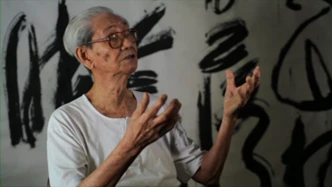
Born in Singapore on 28 September 1921, Lim Tze Peng is Singapore’s oldest living and active artist at 103 years old. Lim occupies a unique position in Singapore’s art history for his persistent innovation in the genres of ink painting and calligraphy, skilfully blending ancient practices with contemporary relevance. Lim is well-known for his subject matters and techniques which varied widely from capturing nostalgic scenes of Singapore, to painting his environments onsite and capturing his memories and emotions through abstract forms, lines, and colours. Lim is a member of various local art groups, including the Ten Men Art Group, Society of Chinese Artist, and Singapore Art Society. Together with his artist friends, and later, on his own, Lim made art expeditions around Singapore, Southeast Asia, and beyond, and he produced numerous paintings and sketches from these travels. In 2003, Lim received the Cultural Medallion, Singapore's highest arts accolade, and was a representative for Singapore at the 5th Shenzhen International Ink Biennale in 2006.
Annex B: Becoming Lim Tze Peng Artwork Highlights
From Dàpō to Xiǎopō
| Artwork | Credit Line |
|---|---|
 | Lim Tze Peng. Singapore River II. c. 1976. Oil on canvas. 76.5 × 203 cm. Gift of the artist. Collection of National Gallery Singapore. Image courtesy of National Heritage Board, Singapore. |
 | Lim Tze Peng. Singapore River (Coleman Bridge). 1979. Ink and colour on paper, 68 × 139 cm. Istana Art Collection. Image courtesy of National Heritage Board, Singapore. |
 | Lim Tze Peng. Hawker. c. 2013–2014. Ink and colour on paper. 96.5 × 96.5 cm. Gift of the artist. Collection of Chung Cheng High School (Main). |
 | Lim Tze Peng. Untitled (Blue Mosque). c. Late 1970. Ink and colour on paper, 68 × 68 cm. Gift of Mr & Mrs Koh Seow Chuan. Collection of National Gallery Singapore. Image courtesy of National Heritage Board, Singapore. |
The World Outside
| Artwork | Credit Line |
|---|---|
 | Lim Tze Peng. Venice. 1996. Oil on canvas. 65 × 80 cm. Gift of the artist and family. Collection of Singapore Art Museum. Image courtesy of National Heritage Board, Singapore. |
 | Lim Tze Peng. Ponte Vecchio, Florence. 1996. Oil on canvas. 65 × 80 cm. Gift of the artist and family. Collection of Singapore Art Museum. Image courtesy of National Heritage Board, Singapore. |
 | Lim Tze Peng. View of the Hills. 2000. Ink and colour on paper. 66.5 × 136 cm. Gift of the artist. Collection of Nanyang Academy of Fine Arts. |
 | Lim Tze Peng. Sumatra. 1970. Oil on canvas, 76 × 101.8 cm. Gift of Mandarin Art Galleries Pte Ltd. Collection of National Gallery Singapore. Image courtesy of National Heritage Board, Singapore. |
 | Lim Tze Peng. Lake Toba. 1970. Oil on canvas, 60 × 75 cm. Gift of the artist and family. Collection of National Gallery Singapore. Image courtesy of National Heritage Board, Singapore. |
On My Own Grounds
| Artwork | Credit Line |
|---|---|
 | Lim Tze Peng. [Not Titled] (Forest Path). 1985. Ink on paper. 52 × 80 cm. Gift of Mr & Mrs Koh Seow Chuan. Collection of National Gallery Singapore. Image courtesy of National Heritage Board, Singapore. |
 | Lim Tze Peng. Untitled (Calligraphy No. 7). 2008. Ink on paper. 151.4 × 85.7 cm. Collection of Singapore Art Museum. Image courtesy of National Heritage Board, Singapore. |
 | Lim Tze Peng. Inroads No.1. 2006. Ink and colour on paper. 263 × 485.5 cm. Collection of Singapore Art Museum. Image courtesy of National Heritage Board, Singapore. |
| Archival Materials & Videos of Lim Tze Peng | |
|---|---|
 | The Ten Men Art Group’s visit to Lake Toba in Sumatra in 1970 marked a pivotal moment in Lim’s ink story. The photographs taken during this trip are the first to document him painting outdoors with an ink brush. |
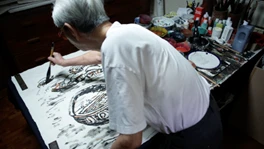 | Two videos that show Lim Tze Peng at work in his studio will be on display in the exhibition. In the first video, the artist makes a large calligraphic work writing a stanza from the poem entitled, “Three Poems on Early Autumn, No. 1” by the Tang poet Xu Hun. The second video sees him painting a scene of boats once used extensively for transport along the Singapore River, with ink and colour pigments. Besides the artist’s process, they offer a glimpse of the humility of the person behind the art. |
Annex C: Becoming Lim Tze Peng Exhibition Programmes,
Tours and Catalogue
For an updated listing of programmes, please visit nationalgallery.sg/BecomingLimTzePeng.
| Programmes | |
|---|---|
| Lim Tze Peng Walking Tour | |
| Date and Time: | Nov 2024 to Feb 2025, 10–11.30am |
| Admission Details: | S$10, registration online required |
| Description: | S$10, registration online required |
| Becoming Lim Tze Peng Education Station | |
| Date and Time: | Oct 2024 to Mar 2025, 10am–7pm Daily |
| Venue: | National Gallery Singapore, City Hall Foyer, Level 4 |
| Admission Details: | Free |
| Description: | Unleash your imagination at the Education Station at the City Hall Foyer on Level 4. Draw inspiration from the art cart showcasing one of Lim Tze Peng’s favourite street scenes and sketch your own! |
| Drop-in Activity at Keppel Centre for Art Education | |
| Date and Time: | Jan 2025 |
| Venue: | National Gallery Singapore, Keppel Centre for Art Education |
| Admission Details: | Free |
| Description: | Inspired by Lim Tze Peng’s calligraphic artworks, bring the family to Keppel Centre for Art Education Expression Workshop and create your calligraphic pieces, just in time for the Lunar New Year! |
| Tours | |
| Curator-led Tours | |
| Date and Time: | Sun 27 Oct 2024, Sat 8 Feb 2025 | English 2pm | Mandarin 11am |
| Admission Details: | City Hall Wing, Level 4 Gallery entrance |
| Description: | Free, online registration required |
| Docent-led Tours | |
| Date and Time: | English | Thu–Sun | 11am Mandarin | Sat–Sun | 2pm |
| Description: | Register for free at our Gallery’s Tours & Programmes counter, located at City Hall Wing, Level 1 |
| Exhibition Catalogue | |
270 × 210 mm Paperback | 208 pages S$ 55 (inclusive of GST) English and Chinese Publisher: National Gallery Singapore | The bilingual catalogue for Becoming Lim Tze Peng, edited by curator Jennifer K. Y. Lam, brings together new writings by leading experts on the artist, excerpts from unpublished artist interviews, and a selection of archival materials – many published for the first time. Together, they chart the terrains of Lim’s long artistic journey while providing rare sources for future research on the artist. The publication is available for purchase at the Gallery Store by ABRY, and select book retailers in Singapore, and internationally. For more information, please contact publications@nationalgallery.sg. |










